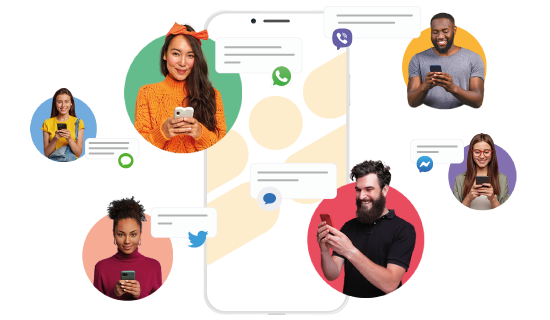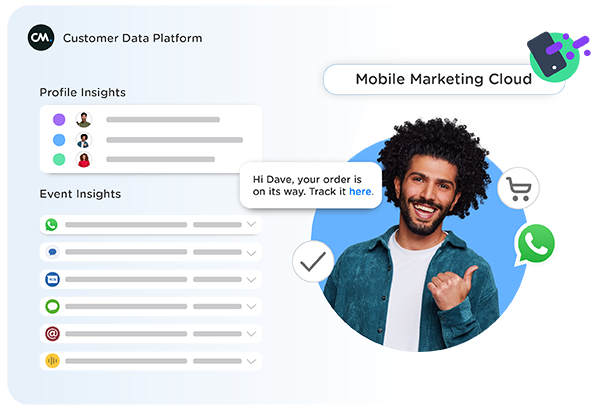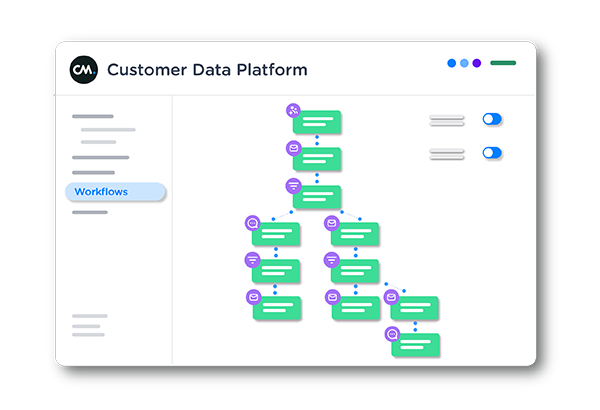- Essential Conversational Channels for Your Business
- WhatsApp Business
- RCS
- Instagram Messaging
- Google Business Messages
- Facebook Messenger
- The Challenge Across Omnichannel Retail & Ecommerce:
- The Solution:
The pandemic has become a touchstone period — quickening years of gradual evolution within a few weeks through a dramatic shift from offline to online shopping. During the pandemic, more than 80% of consumers switched to online shopping. That’s a decade worth of eCommerce growth within just three months.
Truth is - not having an omnichannel strategy in place already puts you behind the competition. Customers expect an uninterrupted, smooth, and immersive experience across all conversational channels, digital marketplaces, app, and websites, including in-store. Brands, therefore, must understand that customers aren’t just present on one channel. Your customers are used to an omnichannel experience, and brands that are flexible enough to seamlessly engage with these customers across all such channels are the ones that will provide the best customer experience.
Customers may prefer using email, Instagram, WhatsApp, or Facebook Messenger, and they expect the brands to meet them on their preferred channel. Managing your eCommerce customer interactions on multiple platforms is crucial, but it can quickly become challenging. So, before we slide into the challenges across delivering an eCommerce omnichannel experience and reveal their solutions, lets first have a look at the most common and essential channels for your business.
Essential Conversational Channels for Your Business
Customers aren’t just phone numbers, email addresses, or WhatsApp handles but distinct individuals who have different preferences and require personal communication. They want to communicate on the channels they are familiar with and are already using - whether that’s via WhatsApp, SMS, Instagram, or voice calls. Nobody wants the hassle to download another app just to communicate for a specific purchase.
Harvard Business Review has stated that the messaging apps “enable a consistent thread between customers and brands”. This thread unlocks the opportunity for continuous communication “and to cross-sell, encourage sharing, solicit input, and flow seamlessly between commerce and support” more frequently which makes dialogues more realistic.
While every channel has its own strengths, most customers use more than one channel on a regular basis. Keeping this in mind, brands can have a chatbot responding to queries on WhatsApp Business or let an agent takeover when the conversation needs a human touch. The objective is to keep the conversation connected even if the user switches between platforms.

CM.com serves as a sole conversational commerce platform where you will find all the communication channels available and ready to integrate with the third-party systems with a single API, ultimately paving the way to omnichannel messaging. Connecting to all messaging apps via one interface allows you to switch between channels so you can continue and manage conversations at scale through multiple channels. Let's have a look at the most popular conversational channels your business must prioritise to provide a wholesome experience.
WhatsApp Business
With nearly 2 billion active users, WhatsApp is one of the most popular and common messaging channels around the world. WhatsApp Business API enable your brand to interact seamlessly with customers in real-time whilst leveraging the rich media features that the channel offers. Here’s a glimpse of how you can use WhatsApp business to power up your eCommerce customer engagement:

- Elevate your communication with rich content like pictures, videos, locations, and more
- With your business WhatsApp account, easily set-up quick replies, show opening hours and your address, and link to your website
- If your customers are confused or not ready to make a purchase, they can get in touch with you to get that extra bit of information and support required
- Use WhatsApp for alerts, notifications, and customer support, and place orders.
- Automate conversations for your customers with a chatbot within WhatsApp Business so that your customer care team has less pressure as the repetitive jobs gets automated and your agents can focus on the conversations that really matter.
As a WhatsApp Business Solution provider, CM.com securely hosts WhatsApp data. Our API is GDPR compliant and secured with end-to-end encryption.
RCS
RCS —Rich Communications Services— might come as an unfamiliar acronym to customers, but millions use it regularly without actually knowing it. As of now, there are some 430m active users. Unlike other channels, it’s not much of an app as a set of protocols that companies can build messaging apps on. With a massive user base and less market recognition, RCS is an interesting yet important part of an omnichannel messaging strategy. For years, SMS has dominated the mobile messaging and is still one of the most reliable channels, but new channels with richer features continue to emerge.
RCS is like modern-day messaging apps, with a big difference in using the carrier networks instead of the internet. It allows brands to enhance how they engage with customers on many different levels.
Instagram Messaging
Instagram is a popular way to connect with brands. Every month 150 million people have a conversation with a business on Instagram through public comments, direct messages, and story replies.
With Instagram Messaging, consumers can message businesses via their Instagram Business profile, their shop, and stories. For businesses, there is a huge opportunity to improve customer satisfaction and drive sales by engaging with people and prospects on Instagram.
The API allows businesses to manage and scale the conversations with their audience on Instagram.
Google Business Messages
Enable consumers to chat with you directly from Google Search, Maps, and across your owned channels with Google’s Business Messages. It offers you a great opportunity in guiding and supporting customers when they need it, anywhere, anytime. With direct access from Google Search, Maps, or across your owned channels, you can deliver helpful, timely, and rich experiences to your customers, across the entire customer journey.
Facebook Messenger
Now separate from the main Facebook mobile app, Facebook Messenger has some subtle differences to WhatsApp Business despite both being owned by the same parent. Facebook Messages tend to be closer to email than WhatsApp’s real-time chats. With a more social aspect than WhatsApp, there’s also a high proportion of bots, with hundreds of thousands of companies using AI to answer common questions and kick-off conversations.
The Challenge Across Omnichannel Retail & Ecommerce:
Lack of Unified Data & Personalization Across All Channels
Omnichannel retail & eCommerce takes a well-integrated approach towards customer engagement and retention. No matter what platforms your customers are on, the experience must remain uninterrupted and seamless. Let's have a look at the challenges across omnichannel retail.
The real challenge for brands is to first understand the channels to improve customer engagement and then basis that craft personalized journeys. Now in order to tackle both these issues, one needs a tool like a Customer Data Platform with the help of which the data collected from various sources can be unified thereby allowing brands to have one single view of their customer's interactions and accordingly help segment them, craft personalized journeys, to facilitate hyper-personalized communication. Customers like choices and they may prefer interacting with a brand via digital channels like online stores, social media platforms, mobile apps, pop-up shops, retail stores, and so on. Data from all such channels must be captured in a CDP in order to facilitate hyper-personalization and deliver customer satisfaction.
For Misguided, one of the leading UK-based fashion brands, adding a Web chatbot was the initial step in a process to help manage customer communication at scale. As Misguided began to experience tremendous growth, their main contact channels – live chat, email, and social – were flooded. All they needed was a quick and easy point solution that could be integrated into their existing architecture. During the first weeks, engagement with the chatbot on the help page was 65%. Fast forward 11 months, engagement with the bot stands at 80%. This high level of bot engagement has resulted in a reduction in costs by 24%.
Every decision we made prior and post-implementation was data-driven. If you work data-driven, results will follow.
Head of Customer Care, Misguided
Customers may also have questions about:
- The services they had availed
- The product bought
- The policies of the brand they invest in or they might need assistance along each touchpoint on their personalised journey.
Here, it was made possible with the help of our Customer Data Platform, which is built to store and make available data which can be used to deliver a superior customer experience.
The Solution:
Identifying The Most Useful Channels and Tracking Customer Behaviour to Set Proactive Cadence Around The Customer Interests
Identifying the most relevant channels as per the region and customer habits is the first step towards an Omnichannel experience. By tracking customer behaviour, mapping all the important events and analysing customer journeys, you can get the list of channels that your customers prefer to use throughout the stages of their eCommerce journey and then build your presence across those channels.
To create a truly omnichannel experience, you need to maintain consistency across all your channels. Everything from your messaging, product information, screenshots, payment options, and how your team interacts with your customers’ needs to be the same across channels. This process can quickly become complicated.

But with smart tools like Mobile Marketing Cloud, you get access to multiple communication streams like email, SMS, WhatsApp, Facebook Messenger, Instagram, RCS, GBM etc. on one unified platform making it easy to manage customer interactions and eliminating requirements of any third-party supplier. It comes with an integrated dashboard which is necessary since it helps you get a 360-degree view of customer data and allows you to create real-time smart segments so that you can personalise the experience accordingly and maintain context. By connecting with customers through a more personalised experience, omnichannel marketing can not only keep businesses relevant and competitive in a crowded market, but also create loyal and - in some cases - lifelong customers. It can also help reach new customer segments, which is key to growth, especially in sales.

Ultimately, Mobile Marketing Cloud’s powerful suite of tools allows you to automate your marketing messages to create personalised campaigns that deliver results, track your customer behaviour and store data in the included Customer Data Platform (CDP) to inform your marketing campaigns. It’s a one-stop shop for omnichannel marketing.
If you’d like to learn more about how CM.com can help you get started with omnichannel marketing, get in touch today!
